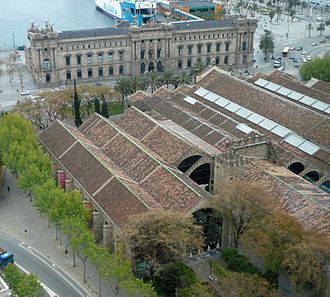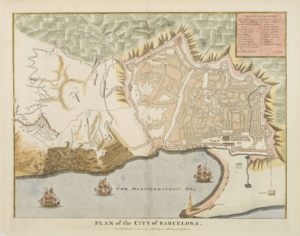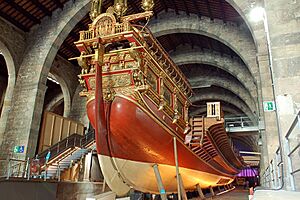Barcelona Royal Shipyard facts for kids
Quick facts for kids Barcelona Royal Shipyard |
|
|---|---|

Aerial view of the building
|
|
| General information | |
| Type | Historic building |
| Architectural style | Gothic |
| Location | Barcelona, Catalonia, Spain |
| Coordinates | 41°22′30″N 2°10′35″E / 41.375°N 2.1763°E |
| Construction started | 13th century |
| Completed | 14th century |
| Renovated | 17th-18th centuries |
The Barcelona Royal Shipyard (also known as Drassanes Reials de Barcelona in Catalan and Atarazanas Reales de Barcelona in Spanish) is a very old building in Barcelona, Spain. It was once a place where ships were built and repaired. It also served as a military building. This amazing structure is built in the Gothic architecture style. You can find it in the Port Vell area, which is part of the Port of Barcelona.
Today, the shipyard is home to the Barcelona Maritime Museum. Building work on the shipyard began in the 13th century. This was during the time of Peter III of Aragon, a king who ruled the area. In 2012, during some digging, people found out something interesting. A new building was constructed in the late 16th century. It was built right on top of the older medieval shipyard. This gave the building the shape we see today. The digging also uncovered an ancient Roman graveyard nearby. The shipyard was fully repaired and finished in early 2013. The museum then opened its doors again in 2014.
Contents
History of the Shipyard
The Barcelona Royal Shipyard was built in several steps. This process took more than 400 years!
Early Beginnings: 13th Century
- The first mention of a shipyard here is from a document in 1241. King James I of Aragon ordered that no buildings should be put up between the city walls and "the atarazana." This word comes from an Arabic word meaning "workshop."
- More building started in 1285, during the War of the Sicilian Vespers. King Peter III of Aragon ordered the shipyard to be built. It was a rectangular fort with strong walls and four towers. Two of these towers are still standing today. The shipyard opened towards the east.
Expanding the Shipyard: 14th Century
- From 1328 to 1390, the shipyard grew bigger. The city walls were extended to include the shipyard inside the protected city.
- A roof was added to the building. This was important to protect the galley ships stored there during the winter months.
New Additions: 15th Century
- Construction continued from 1390 to 1415. A new section called Porxo No was added. This part is also known as Pere IV.
- This area was originally planned to be a royal palace. However, the idea was later dropped. Digging has shown that only the foundations for the palace were ever built.
Moving Inland: 16th Century
- The old medieval building was replaced by a new shipyard. This new one was built a few meters further inland.
- The builders still used the Gothic architecture style. This was because it was known to be strong and practical at the time. This choice made it hard for historians to figure out the building's age later on!
- The new port of Barcelona was built in the 15th century. This changed the ocean currents and moved the shoreline inland. The old shipyard often flooded, which is why the new one was built further away from the water.
Changes and Military Use: 17th and 18th Centuries
- In 1612, the government of Catalonia decided to add three more large halls, called naves, to the building.
- After the Catalan Revolt (1640–1652), the Spanish government made the shipyard even bigger. It was used as both a place to store weapons (an arsenal) and a place for soldiers to live (barracks).
- In 1725, two more barracks were built for soldiers. One was for cavalry (soldiers on horseback) and one for infantry (soldiers who fight on foot). These barracks were taken down in 1935.
- The last big change happened between 1742 and 1749. The roofs of the two central naves were joined together to form one large hall, known as Nau Central.
Building Warships and More
From the very beginning, the shipyard's main goal was to build galley ships for the Aragonese Armada, which was their navy. The shipyard also served as a naval arsenal. This meant it was used to store galleys and all the equipment they needed. This included ropes, sails, and other parts. The arsenal also made many things, like sails and ropes for the ships. They also made weapons for the soldiers. Naval arsenals in those days usually had to produce and store food too.
After a renovation in 1381, the building had eight large halls, or naves. Each nave was about 8.4 meters (27.5 feet) high and 8.4 meters wide. They were also about 60 meters (197 feet) long. Each nave had 17 columns that were 77 centimeters (30 inches) wide and 6 meters (20 feet) high. We know from old records that four new storage areas were also built.
The stone used for building, called Ashlar, came from the nearby mountain of Montjuïc. Sand came from the beach right in front of the shipyard. Wood came from the Baix Ebre and Gavarres areas. Ropes and tiles were brought from Valencia.
The shipyard was busiest during the rule of Alfonso V of Aragon. In 1423, they built twelve galleys at the same time! In 1571, a very famous royal galley called the Real was built here. This ship was the main ship for John of Austria at the important Battle of Lepanto. You can see a copy of this famous galley at the Barcelona Maritime Museum today.
Later Uses and Museum
During the 18th century, shipbuilding moved to the Cartagena shipyard. After the War of Spanish Succession, the Barcelona Royal Shipyard was used by the Spanish Army. It became an artillery barrack. This meant it was used to build, store, and repair cannons and other artillery weapons.
In 1935, the building was given to the Barcelona city hall. They decided to turn it into a maritime museum. The museum first opened its doors in 1941.
On July 19 and 20, 1936, a battle took place at the shipyard. This happened shortly after a military uprising that led to the Spanish Civil War. Soldiers fought against a group of workers' militia. The militia won the battle.
On May 5, 1976, the building was officially recognized as a Cultural Site of National Interest. This means it is a very important historical and cultural landmark.
Getting There by Metro
The closest subway or tube station is called Drassanes. This is the Catalan word for shipyard! It is on the ![]() line of the Barcelona Metro network.
line of the Barcelona Metro network.
See also
 In Spanish: Atarazanas Reales de Barcelona para niños
In Spanish: Atarazanas Reales de Barcelona para niños
- Catalan Gothic



